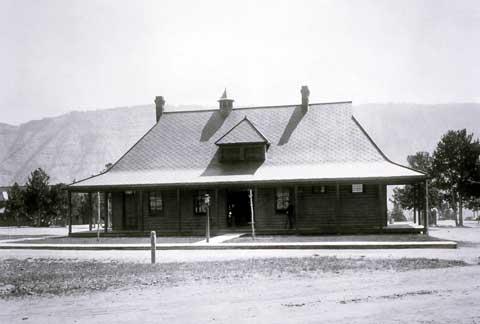Visitors to Yellowstone National Park—and any other areas where bears are part of the equation—should always follow common-sense rules to avoid a confrontation with a bruin. At times, however, "common-sense" seems to be in short supply, as this true story from the past confirms.
There's been a bit of discussion lately on the Traveler about the pros and cons of bear pepper spray, guns or simply the use of good judgment as the best defense against the rare threat from a bear. The 1901 Report of the Secretary of the Interior includes the tale of a visitor to Yellowstone who tried a different approach that may have seemed like a good idea at the time, but definitely failed the "upon further review" test.
A very brief history review may be helpful in fully understanding this story. Yellowstone National Park was established in 1872, but the National Park Service didn't come along until 1916. A serious void in management and staffing during Yellowstone's early years was filled by the U.S. Army, which was assigned the responsibility of protecting the park between 1886 and 1916.
The Fort Yellowstone mentioned in this account was built by the army for its base of operations, and later provided some literal foundations for park headquarters. When a problem arose in the "old days" in Yellowstone, one could literally say, "Send in the cavalry!" The 1901 report notes:
The acting superintendent states that he found but one troop of cavalry stationed in the park, and later, on account of the unusually dry season and the large number of camping parties in the park, it was necessary to increase the number. Capt. E. Lindsey was accordingly sent by the Adjutant-General to report for duty, and arrived at Fort Yellowstone, with his troop, August 3. They were at once sent to a camp in Lower Geyser Basin, where they did much hard work and rendered valuable service in extinguishing some large fires.
There were three large fires during the season. The first, in Gibbon Canyon, was started by a camper traveling through the park who, becoming frightened by a bear, built three large fires about his camp. The patrol compelled him to extinguish them during the night, and he was cautioned as to the danger of forest fires, but he rebuilt the fires after the patrol left and failed to entirely extinguish them. As a result, the fires started up again and developed into a serious conflagration, causing one day's delay in travel on that part of the road. The camper was arrested, brought to Fort Yellowstone, fined $50 and costs by the United States commissioner, and, being unable to pay his fine, served out his sentence in the post guardhouse.
The report was silent on how many days it took to pay off "$50 and costs," but at least the post guardhouse shown in the photo looks reasonably comfortable—and it provided sanctuary from the bears.


 Support Essential Coverage of Essential Places
Support Essential Coverage of Essential Places







Comments
Great article, Jim. I spent last summer working as a field technician in YNP, and I could not believe just how many visitors to the park lacked that "common sense." As part of my training, I was required to take a bear safety course provided by the NPS at the training center in Gardiner, MT. The speakers provided us with some interesting mortality statistics of YNP since the parks conception, which are well documented in the book "Death in Yellowstone: Accidents and Foolhardiness in the First National Park" (http://www.amazon.com/Death-Yellowstone-Accidents-Foolhardiness-National...).
Something interesting to know, more people die annually from bison attacks than grizzly bear attacks. And over the course of YNP's existence, more people have died in park boundaries as a result of Native American ambushes than from grizzly bear attacks. Thanks for posting. Hoping that I will be back in YNP this summer working on, well, a grizzly bear study!
RJ
RJ -
Thanks for an excellent comment, including the useful perspective on the small number of actual grizzly bear attacks.
Hope you'll be back in the park this summer!